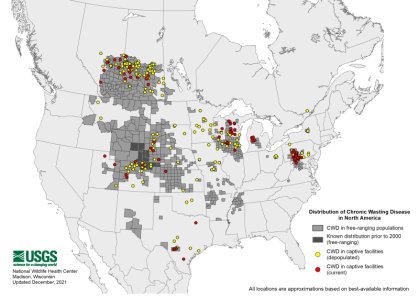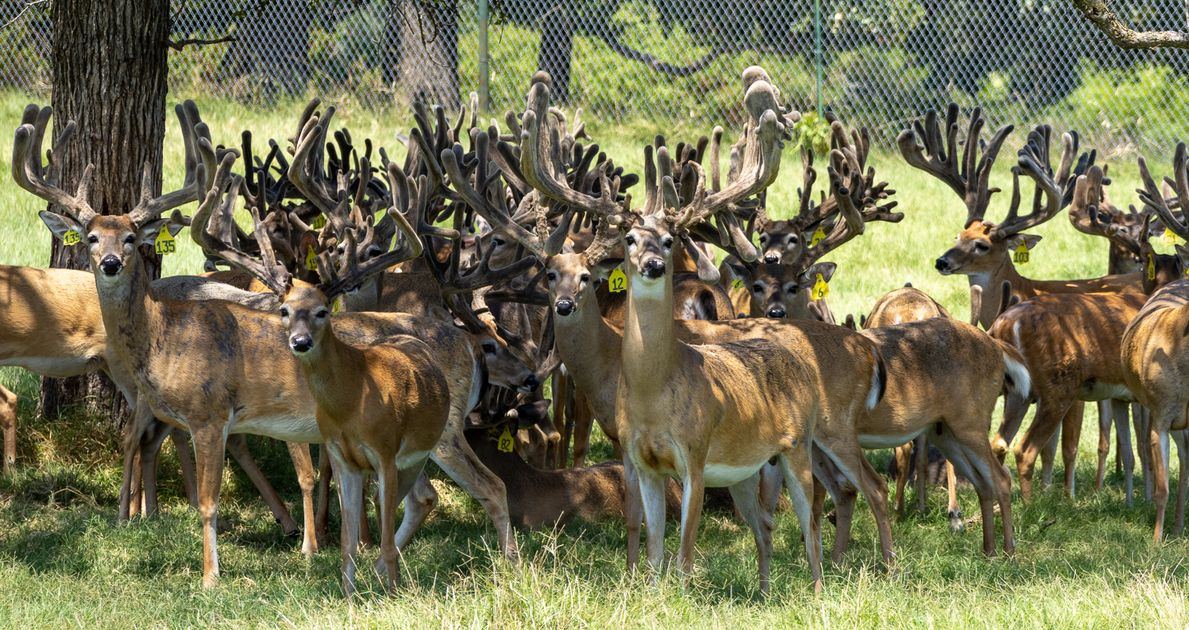TPWD Executive Order No. 23-003 CWD Emergency Rules Adopted for Movement of Breeder Deer
Executive Orders
2023
Executive Order No. 23-003
Date: July 24, 2023
The Executive Director finds that additional discoveries of CWD in free-ranging white-tailed deer within deer breeding facilities regulated under Parks and Wildlife Code, Chapter 43, Subchapter L and regulations adopted pursuant to that subchapter (31 TAC Chapter 65, Subchapters B and T) constitute an immediate danger to the white-tailed deer and mule deer resources of Texas and that the adoption of rules on an emergency basis with fewer than 30 days' notice is necessary to address an immediate danger.
https://tpwd.texas.gov/publications/executive_orders/
Emergency Rules Adopted for Movement of Breeder Deer
July 25, 2023
Media Contact: TPWD News, Business Hours, 512-389-8030
AUSTIN — In response to continued positive detections of Chronic Wasting Disease (CWD) in deer breeding facilities, Texas Parks and Wildlife Department (TPWD) has adopted an emergency rule implementing additional movement and testing restrictions for white-tailed deer in deer breeding facilities.
Since June, TPWD has received confirmation of CWD in deer breeding facilities in three counties- Brooks, Frio and Zavala. In 2023 alone, CWD has been detected in nine deer breeding facilities in seven counties. A total of 14 counties have had positive detections since March 2021.
"Since 2021, we have seen an increase in CWD detections from breeder deer at an unprecedented rate," said John Silovsky, Wildlife Division Director for TPWD. "It's our hope that these emergency rules will strengthen our surveillance and reduce the number of CWD positive detections across the state."
This emergency order amends Chapter 31 TAC §65.95, relating to Movement of Breeder Deer. The change requires all breeder deer to be ante-mortem (live-animal) tested for CWD (with a test result of "Not Detected") before transferring to another deer breeding facility or release site. These changes will be in effect for 120 days but may be extended an additional 60 days.
Additionally, the department has determined that to expedite and facilitate epidemiological investigations, it is necessary to prohibit the removal of identification tags under any circumstance other than allowed by statute. The ability to quickly locate and test breeder deer transferred to a release facility is critical to determining the likelihood of disease transmission.
CWD is a fatal neurological disease found in certain cervids including deer, elk, moose and other members of the deer family. This slow, progressive disease may not produce visible signs in susceptible species for several years after infection. As the irreversible disease process continues, animals with CWD may show changes in behavior and appearance. Clinical signs may include progressive weight loss, stumbling or tremors with a lack of coordination, loss of appetite, teeth grinding, abnormal head posture and/or drooping ears, and excessive thirst, salivation or urination.
Visit TPWD's recently updated CWD page to find a map of all CWD zones, check stations and positive case tracking. The site also provides answers to frequently asked questions, videos with information from wildlife veterinarians, best management practices for hunters and landowners and review the latest news.
https://tpwd.texas.gov/newsmedia/releases/?req=20230725a
Executive Orders
2023
Executive Order No. 23-003
Date: July 24, 2023
Under the provisions of Parks and Wildlife Code, §12.027, if the Texas Parks and Wildlife Commission (the Commission) or the Executive Director of the Texas Parks and Wildlife Department (Executive Director) finds that there is an immediate danger to a species authorized to be regulated by the Department, the Commission or the Executive Director may adopt emergency rules as provided by Government Code, §2001.034.
White-tailed deer and mule deer are game animals subject to regulation by the Commission under the provisions of various chapters of the Parks and Wildlife Code, including Chapters 43 (Subchapters E, L, R, and R-1), 61, 62, and 63. Chronic Wasting Disease (CWD) is a fatal neurodegenerative disorder that affects some cervid species, including white-tailed deer and mule deer.
The Executive Director finds that additional discoveries of CWD in free-ranging white-tailed deer within deer breeding facilities regulated under Parks and Wildlife Code, Chapter 43, Subchapter L and regulations adopted pursuant to that subchapter (31 TAC Chapter 65, Subchapters B and T) constitute an immediate danger to the white-tailed deer and mule deer resources of Texas and that the adoption of rules on an emergency basis with fewer than 30 days' notice is necessary to address an immediate danger.
The emergency rules require all breeder deer to be tested for CWD (with a test result of "Not Detected") by means of an approved ante-mortem (live-animal) test as a condition of transfer to another deer breeding facility and expressly prohibit the removal of an identification tag prescribed by Parks and Wildlife Code, §43.3561, from a breeder deer except to immediately replace it with an identification tag meeting the requirements of Parks and Wildlife Code, §43.3561(c) or (h).
Therefore, finding that the immediate danger to both captive and free-ranging white-tailed and mule deer populations exists, the Executive Director hereby ORDERS the adoption, on an emergency basis, of an amendment to 31 TAC §65.95, concerning Movement of Breeder Deer, and §65.611 (relating to Prohibited Acts), in response to the ongoing and most recent detections of chronic wasting disease (CWD) in additional deer breeding facilities.
This order is effective immediately upon filing, and authorizes publication of a Notice of Extension of Emergency Adoption in the Texas Register.
This order is issued pursuant to §12.027 of the Texas Parks and Wildlife Code and §2001.034 of the Texas Government Code and is effective immediately.
Signed this 24th day of July, 2023.
https://tpwd.texas.gov/publications/executive_orders/
see full text and more here;
WEDNESDAY, JULY 26, 2023
TPWD Executive Order No. 23-003 CWD Emergency Rules Adopted for Movement of Breeder Deer
https://chronic-wasting-disease.blogspot.com/2023/07/tpwd-executive-order-no-23-003-cwd.html
Executive Orders
2023
Executive Order No. 23-003
Date: July 24, 2023
The Executive Director finds that additional discoveries of CWD in free-ranging white-tailed deer within deer breeding facilities regulated under Parks and Wildlife Code, Chapter 43, Subchapter L and regulations adopted pursuant to that subchapter (31 TAC Chapter 65, Subchapters B and T) constitute an immediate danger to the white-tailed deer and mule deer resources of Texas and that the adoption of rules on an emergency basis with fewer than 30 days' notice is necessary to address an immediate danger.
https://tpwd.texas.gov/publications/executive_orders/
Emergency Rules Adopted for Movement of Breeder Deer
July 25, 2023
Media Contact: TPWD News, Business Hours, 512-389-8030
AUSTIN — In response to continued positive detections of Chronic Wasting Disease (CWD) in deer breeding facilities, Texas Parks and Wildlife Department (TPWD) has adopted an emergency rule implementing additional movement and testing restrictions for white-tailed deer in deer breeding facilities.
Since June, TPWD has received confirmation of CWD in deer breeding facilities in three counties- Brooks, Frio and Zavala. In 2023 alone, CWD has been detected in nine deer breeding facilities in seven counties. A total of 14 counties have had positive detections since March 2021.
"Since 2021, we have seen an increase in CWD detections from breeder deer at an unprecedented rate," said John Silovsky, Wildlife Division Director for TPWD. "It's our hope that these emergency rules will strengthen our surveillance and reduce the number of CWD positive detections across the state."
This emergency order amends Chapter 31 TAC §65.95, relating to Movement of Breeder Deer. The change requires all breeder deer to be ante-mortem (live-animal) tested for CWD (with a test result of "Not Detected") before transferring to another deer breeding facility or release site. These changes will be in effect for 120 days but may be extended an additional 60 days.
Additionally, the department has determined that to expedite and facilitate epidemiological investigations, it is necessary to prohibit the removal of identification tags under any circumstance other than allowed by statute. The ability to quickly locate and test breeder deer transferred to a release facility is critical to determining the likelihood of disease transmission.
CWD is a fatal neurological disease found in certain cervids including deer, elk, moose and other members of the deer family. This slow, progressive disease may not produce visible signs in susceptible species for several years after infection. As the irreversible disease process continues, animals with CWD may show changes in behavior and appearance. Clinical signs may include progressive weight loss, stumbling or tremors with a lack of coordination, loss of appetite, teeth grinding, abnormal head posture and/or drooping ears, and excessive thirst, salivation or urination.
Visit TPWD's recently updated CWD page to find a map of all CWD zones, check stations and positive case tracking. The site also provides answers to frequently asked questions, videos with information from wildlife veterinarians, best management practices for hunters and landowners and review the latest news.
https://tpwd.texas.gov/newsmedia/releases/?req=20230725a
Executive Orders
2023
Executive Order No. 23-003
Date: July 24, 2023
Under the provisions of Parks and Wildlife Code, §12.027, if the Texas Parks and Wildlife Commission (the Commission) or the Executive Director of the Texas Parks and Wildlife Department (Executive Director) finds that there is an immediate danger to a species authorized to be regulated by the Department, the Commission or the Executive Director may adopt emergency rules as provided by Government Code, §2001.034.
White-tailed deer and mule deer are game animals subject to regulation by the Commission under the provisions of various chapters of the Parks and Wildlife Code, including Chapters 43 (Subchapters E, L, R, and R-1), 61, 62, and 63. Chronic Wasting Disease (CWD) is a fatal neurodegenerative disorder that affects some cervid species, including white-tailed deer and mule deer.
The Executive Director finds that additional discoveries of CWD in free-ranging white-tailed deer within deer breeding facilities regulated under Parks and Wildlife Code, Chapter 43, Subchapter L and regulations adopted pursuant to that subchapter (31 TAC Chapter 65, Subchapters B and T) constitute an immediate danger to the white-tailed deer and mule deer resources of Texas and that the adoption of rules on an emergency basis with fewer than 30 days' notice is necessary to address an immediate danger.
The emergency rules require all breeder deer to be tested for CWD (with a test result of "Not Detected") by means of an approved ante-mortem (live-animal) test as a condition of transfer to another deer breeding facility and expressly prohibit the removal of an identification tag prescribed by Parks and Wildlife Code, §43.3561, from a breeder deer except to immediately replace it with an identification tag meeting the requirements of Parks and Wildlife Code, §43.3561(c) or (h).
Therefore, finding that the immediate danger to both captive and free-ranging white-tailed and mule deer populations exists, the Executive Director hereby ORDERS the adoption, on an emergency basis, of an amendment to 31 TAC §65.95, concerning Movement of Breeder Deer, and §65.611 (relating to Prohibited Acts), in response to the ongoing and most recent detections of chronic wasting disease (CWD) in additional deer breeding facilities.
This order is effective immediately upon filing, and authorizes publication of a Notice of Extension of Emergency Adoption in the Texas Register.
This order is issued pursuant to §12.027 of the Texas Parks and Wildlife Code and §2001.034 of the Texas Government Code and is effective immediately.
Signed this 24th day of July, 2023.
https://tpwd.texas.gov/publications/executive_orders/
see full text and more here;
WEDNESDAY, JULY 26, 2023
TPWD Executive Order No. 23-003 CWD Emergency Rules Adopted for Movement of Breeder Deer
https://chronic-wasting-disease.blogspot.com/2023/07/tpwd-executive-order-no-23-003-cwd.html


